Metrics and dimensions in GA4 are the building blocks of every report and analysis. In this post you will learn how to best leverage these key elements of GA4.
7 Years ago I wrote a post on effectively using metrics and dimensions in Universal Analytics. With the introduction of GA4 a lot has changed, a good reason to write another post on this topic!
Let’s dive into GA4 and these key elements you need to focus on when building reports and analyzing data.
Introduction: GA4 Metrics and Dimensions
Here is a simplified overview of a standard report in GA4:
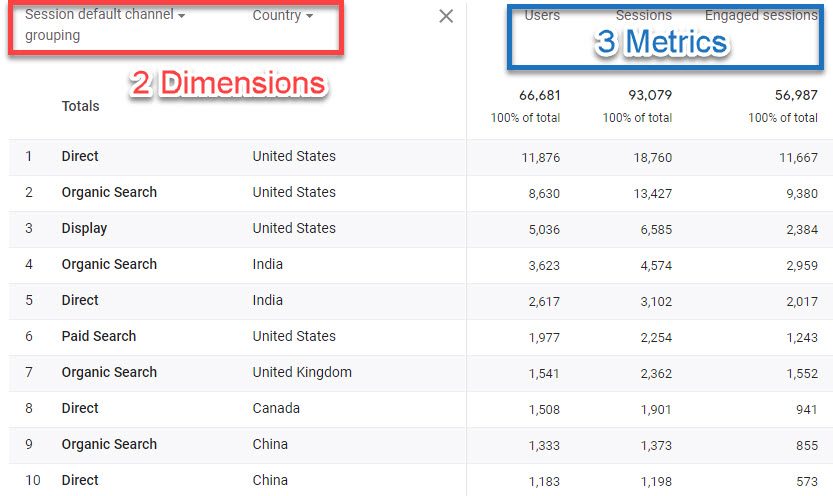 This report consists of:
This report consists of:
- Two dimensions: Session default channel grouping and Country
- Three metrics: Users, Sessions and Engaged sessions
On default, Google Analytics 4 shows just one dimension in standard reports.
You can add an additional / secondary dimension via the “+” sign next to the primary dimension.

“Country” was added as a secondary dimension in my first report.
Tip 1: Know the Difference
This might sound like a no-brainer, but you will be surprised… There are many people (even experienced analysts) who sometimes mix up metrics and dimensions in GA4.
Some people might say:
“A metric is tied to a number and a dimension isn’t.”
In most cases this is true, but unfortunately not always.
Two examples of dimensions that are actually numbers:
- dateHour (example: 2022020202)

- screenResolution (example: 1920×1080)
 So how can you distinguish between metrics and dimensions in GA4?
So how can you distinguish between metrics and dimensions in GA4?
- A dimension is a characteristic of an object that can be given different values —> a dimension describes data
- A metric is an individual element of a dimension which can be measured as a sum or ratio —> a metric measures data
Tip 2: GA4 ≠ GA3 (Universal Analytics)
Ok, let me explain this in more depth.
- There are far less (default) metrics and dimensions available in GA4.
- New metrics and dimensions are introduced and others have disappeared.
Did you know that bounce rate is not a default metric in GA4?
I know this has led to disappointment, but please keep in mind that the default bounce rate in GA3 isn’t the best metric. GA4 comes with bettter metrics in this area, but that’s a topic I will discuss in a separate post.
Just be aware that you need to change your mindset and be open when working with GA4. You can’t simply copy your metrics and dimensions strategy of GA3.
Tip 3: Get Familiar
Visiting the GA4 Dimensions and Metrics Explorer is one of the best things you can do to get started.
Step 1: Follow the link mentioned above and select GA4.
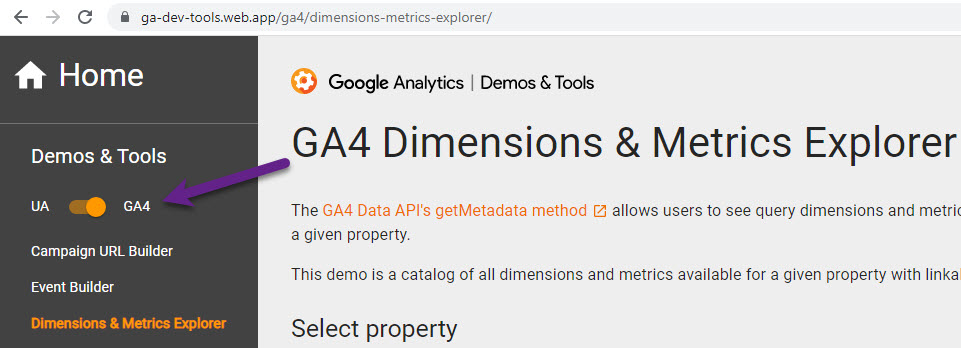
Step 2: Select a GA4 property that you have access to.
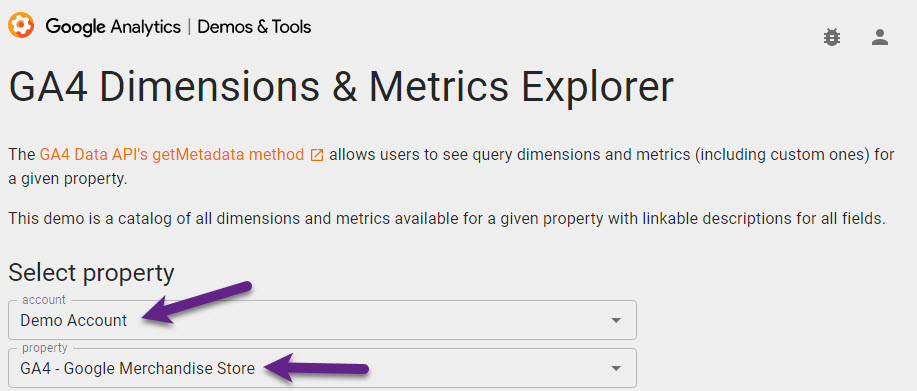
Tip: get access to the GA4 Demo Account if you don’t have GA4 properties set up yet.
Step 3: Review all available dimensions and metrics.

Tip: you can review non-default custom dimensions and metrics as well:
- Event-scoped Custom Metrics
- Event-scoped Custom Dimensions
- User-scoped Custom Dimensions
Later, I will share more details on these custom metrics and dimensions in GA4.
Tip 4: Use Them in the Query Explorer
Not all metrics and dimensions go together.
You have the option to explore potential queries in all depth in the GA4 dimensions and metrics explorer.
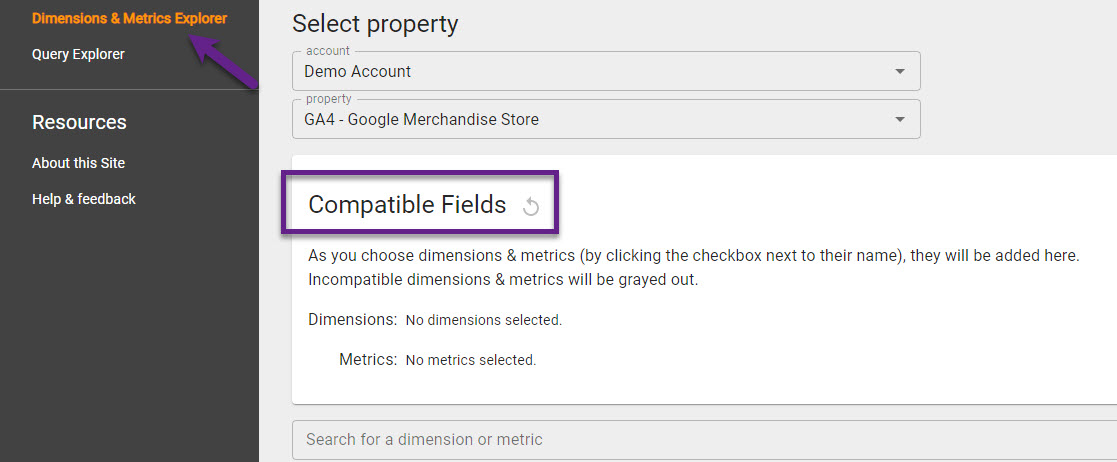
Let me show you one example of two metrics that don’t work together with all dimensions.

Now let’s type “cohort” in the search field.
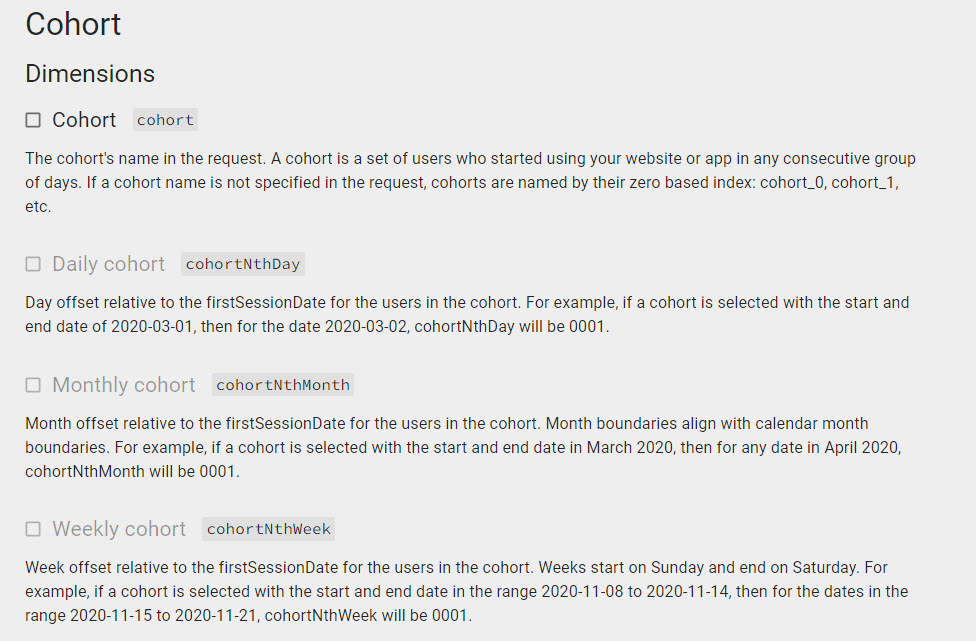
It turn out that addToCarts and checkouts don’t go together with cohortNth dimensions.
In addition to the above, you can use the GA4 Query Explorer directly to do some pre-work on building queries.
Query Explorer – request
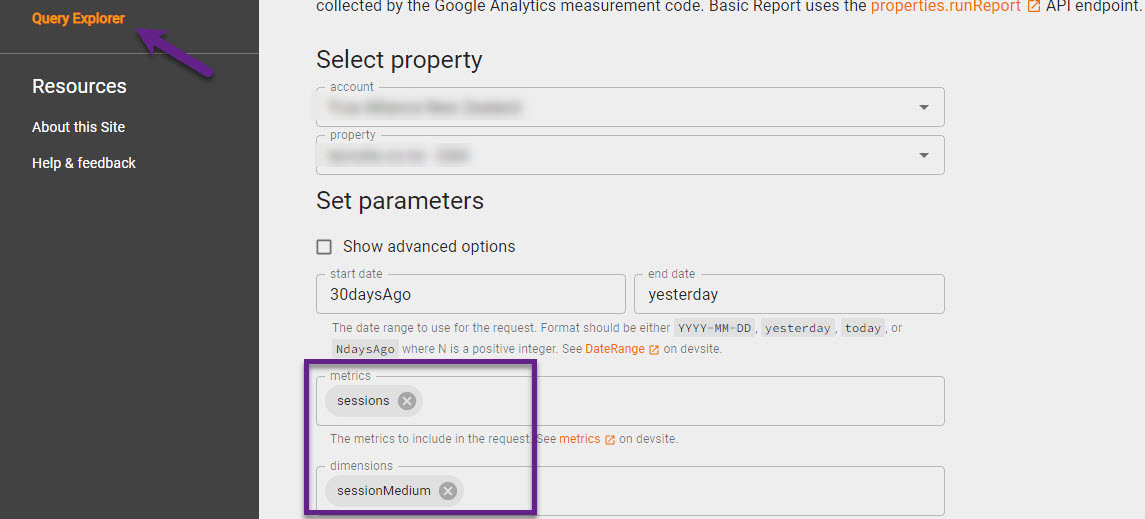
Query Explorer – response
At the bottom of the page, click on “Make Request”.
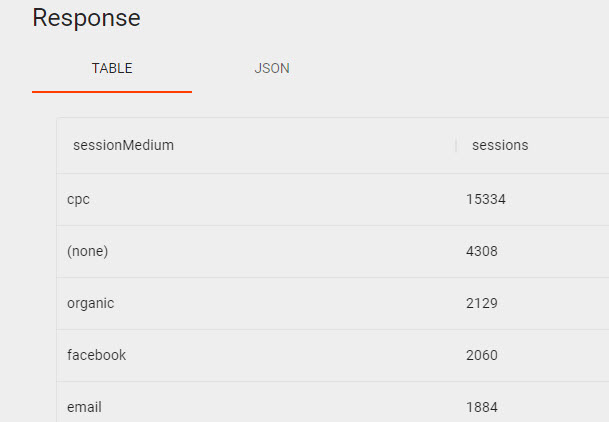
Query Explorer – advanced options
You have many more options when fine-tuning your query (below).
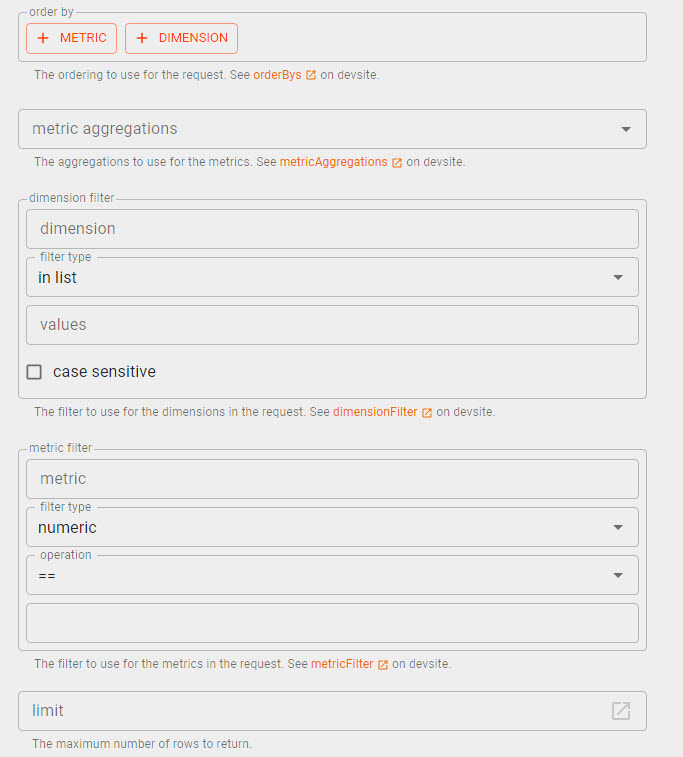
Here is an example of a metric filter and the response.
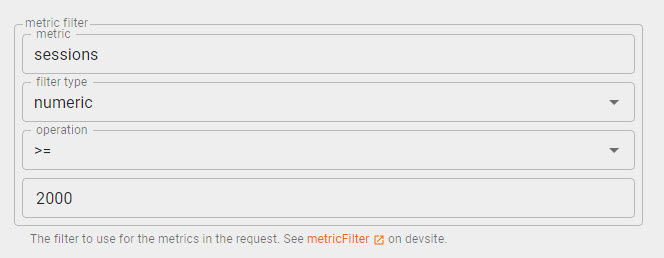
In this case we only want to include mediums with at least 2,000 sessions.
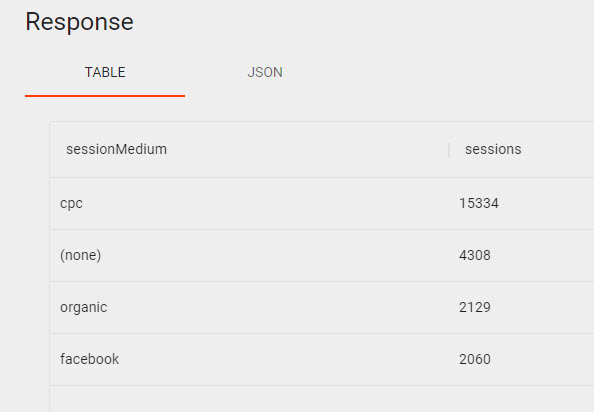
Two more notes:
- (Obviously), you can only use the GA4 Query Explorer on GA4 properties you have access to.
- This API GA4 Dimensions & Metrics overview is very handy to bookmark as well.
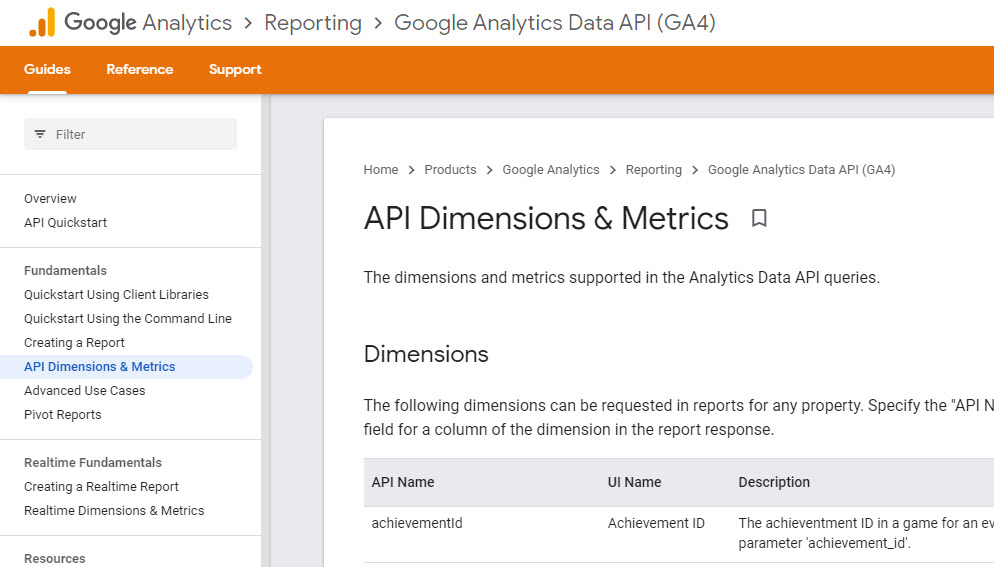
Tip 5: Leverage Them in Comparisons
In the previous post, I wrote about comparisons in GA4. Read this post to learn all details.
Within the default reports you can build “segments” (named comparisons) based on dimension values.
Here is an example of how it works.
Step 1: Click on Add comparison in the default report.
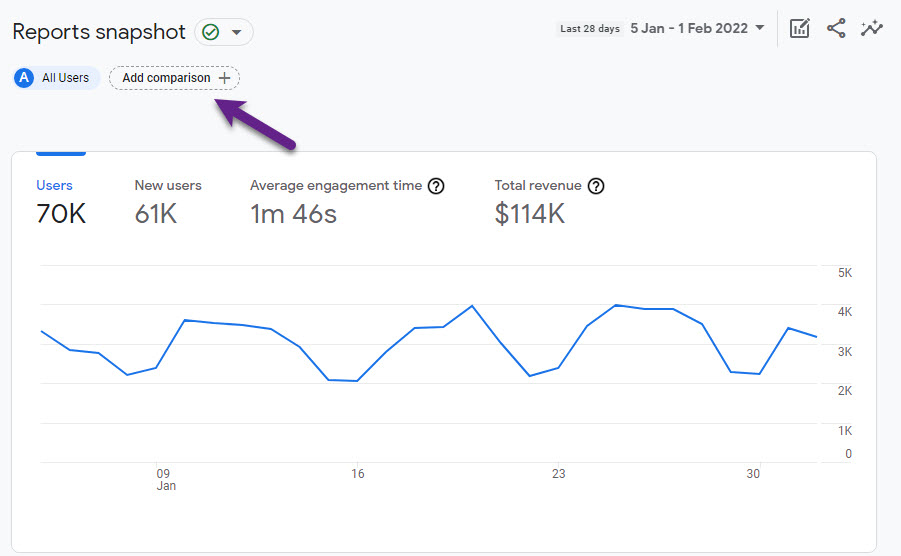
Step 2: Create comparison and click “apply” (bottom).
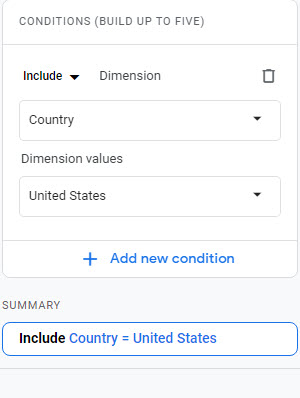 Last step: Review the new report that includes All Users and the newly created Comparison.
Last step: Review the new report that includes All Users and the newly created Comparison.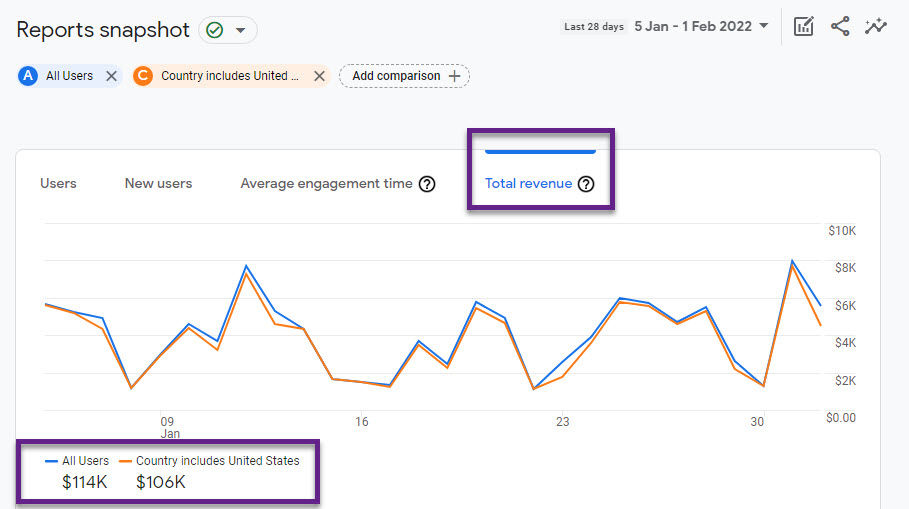
The focus is on the “Total revenue” metric with the “Country” dimension (value = United States).
It’s clear that on this store most revenue comes from the United States.
Tip: you can review all default reports with this extra layer applied. Unfortunately, you need to recreate these comparisons when you end your session and come back at a later time.
Tip 6: Build Powerful Segments
GA4 greatly empowers you with additional options in the “Explore” section.
This is where you can create segments for an in-depth analysis.
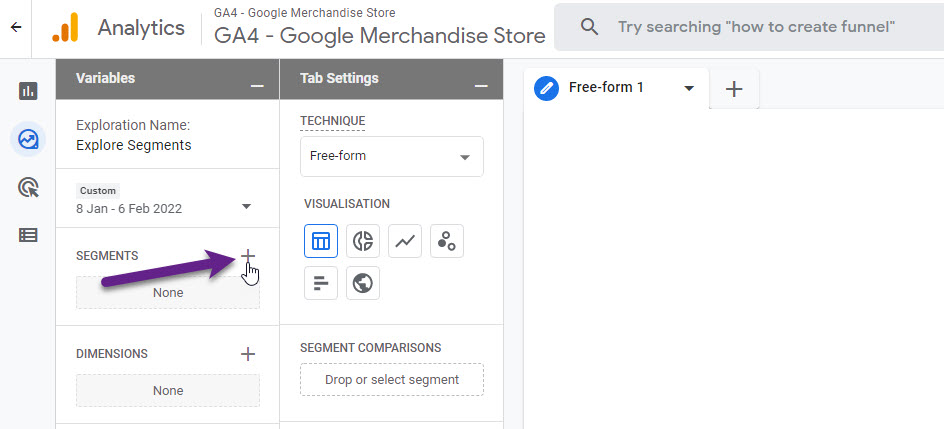
Read this blogpost to learn more about creating segments in GA4.
In short, currently you can create segments based on event names, dozens of dimensions and a handful of predictive metrics. The user-scoped predictive metrics are only available in user-level segments.
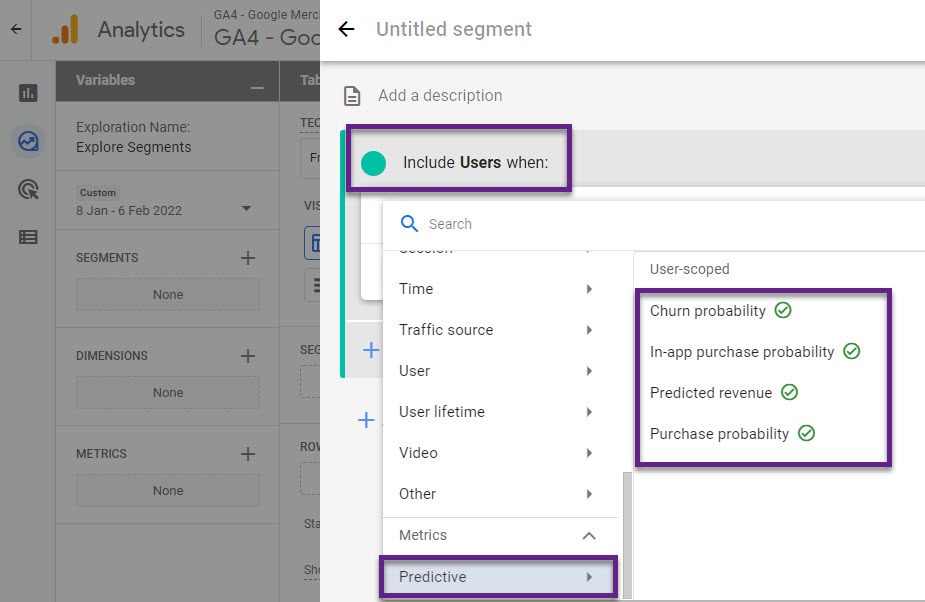
Tip 7: Build Powerful Audiences
Another great way to work with dimensions and metrics in GA4 is by building audiences.
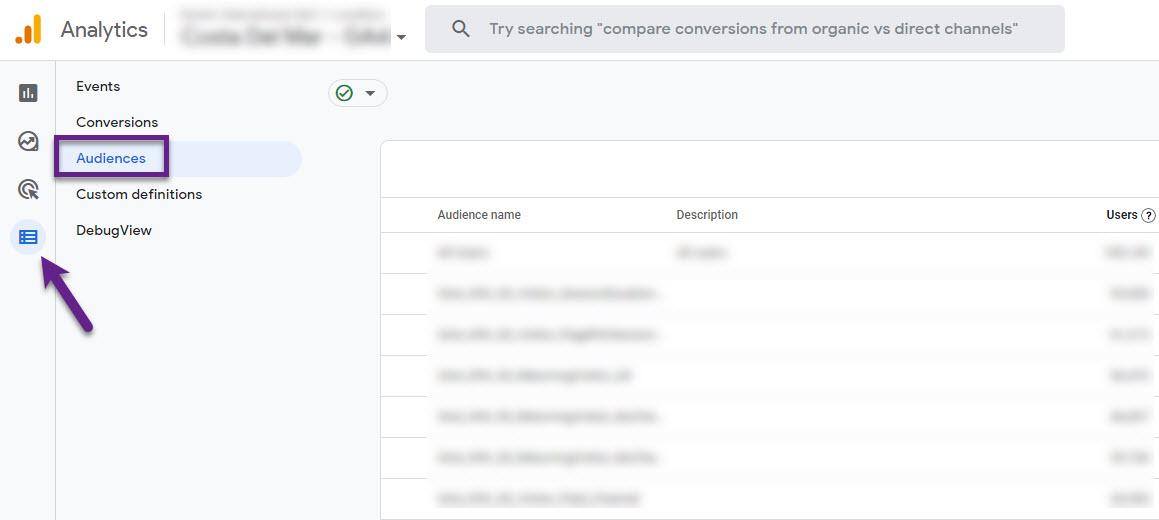
In the top right button you will see a blue button “New audience”. The screen below appears after you click on that button.
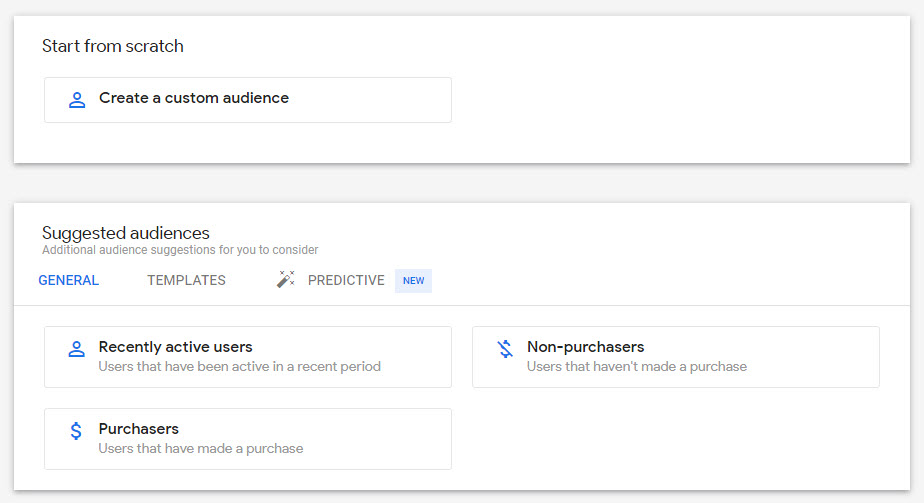 You can either use a suggested audience (with predefined metrics and dimensions) or create one yourself.
You can either use a suggested audience (with predefined metrics and dimensions) or create one yourself.
Let’s have a look at custom audiences.
In terms of available metrics and dimensions, it’s very similar to user-level segments.
You have an additional option to create an audience based on LTV which can be very powerful.
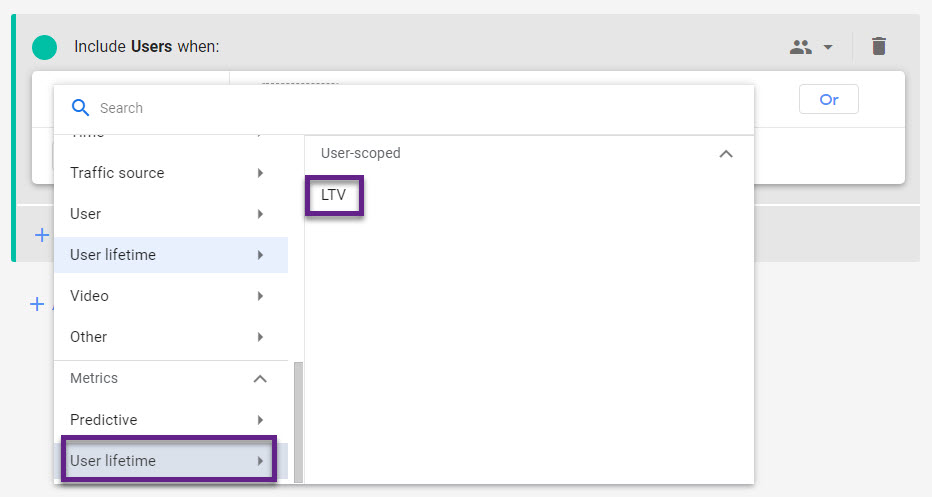
Tip: Your audiences are available in your shared library in Google Ads if you link your GA4 property to Google Ads and keep the default option to Enable Personalized Advertising.
Tip 8: Export Them via the Data API
I have already mentioned the Google Analytics 4 Data API schema.
It’s very useful to bookmark this page and keep it as a resource for when you need to know which metrics and dimensions you can exactly query (this might change over time).
In addition, for advanced users and Dev enthusiasts, here is the GA4 API Quickstart guide.
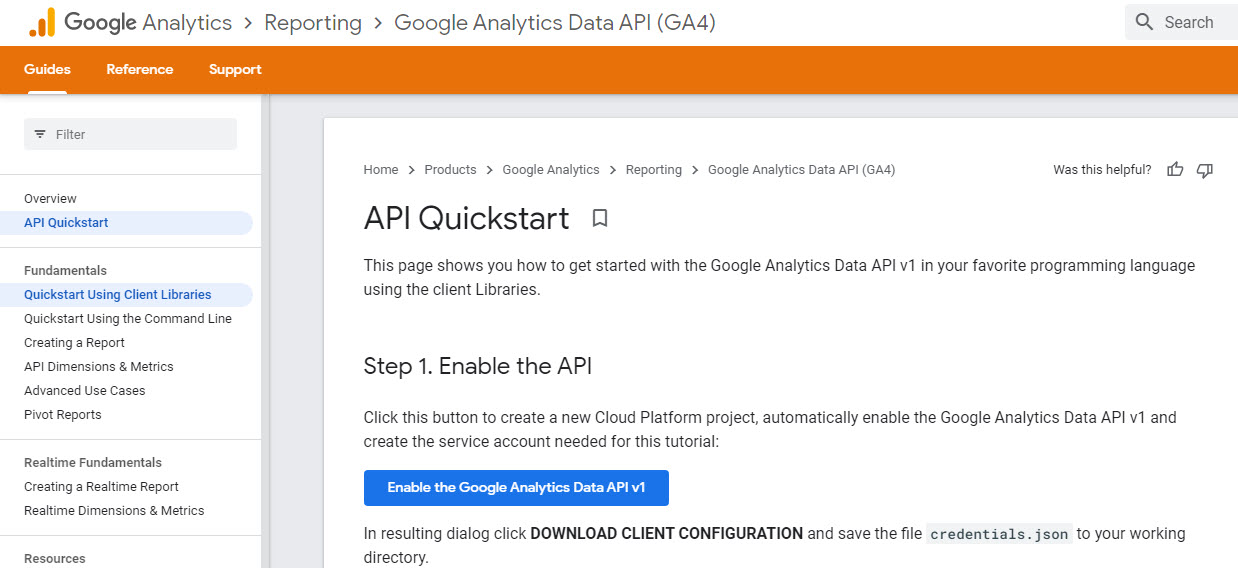
Tip: watch this video from Mark Edmondson if you want to learn more about the GA4 API.
Tip 9: Set up Custom Dimensions and Metrics
GA4 is very different compared to GA3/Universal Analytics when it comes to Event Tracking. Every hit is an “event” and you can add multiple parameters to provide context to each of your events.
In GA4 most parameters are not available on default and you need to register them as custom definitions (custom dimensions and metrics).
That’s why I recommend mapping out all the events that you want to track including the corresponding parameters. Also, register those (that are not available on default) in the GA4 interface.
Step 1: Go to “Custom definitions” in the GA4 interface.
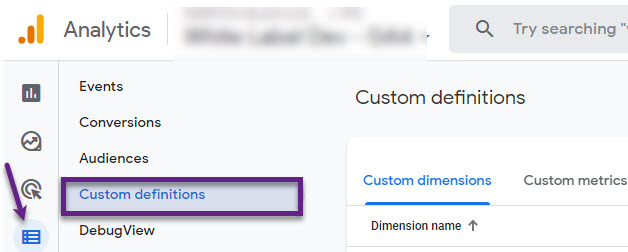
Step 2: Create new custom dimensions and metrics.
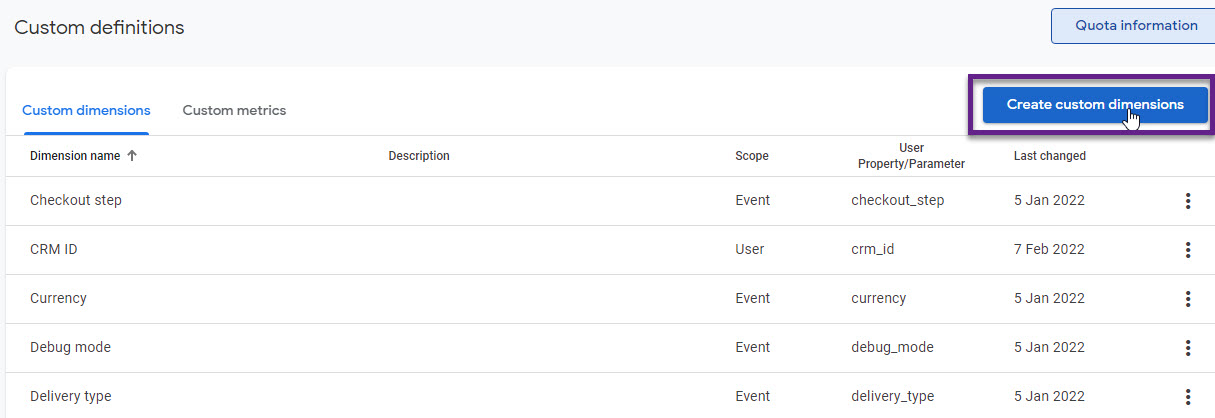
Read this support article if you need more information on the creation process and limits.
After +/- 24 hours they will become available in the “Explore” section. You can then use them to build custom reports and analyze your data.
Also, you can leverage user-scoped custom dimensions in segments and audiences.
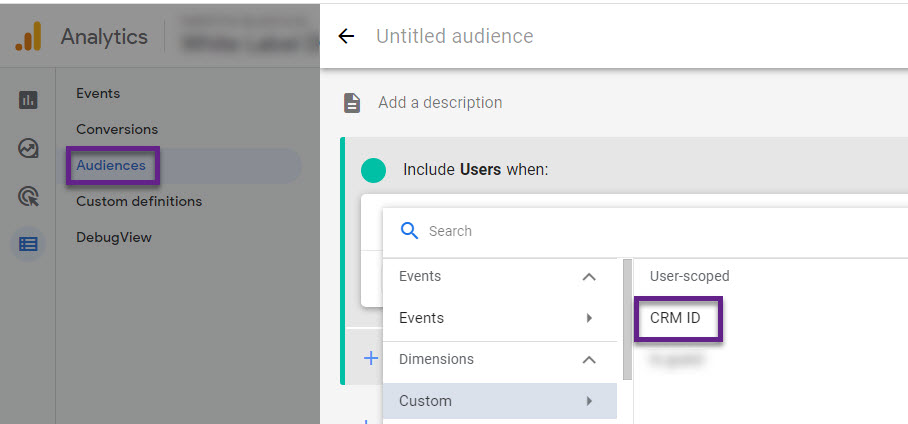 In short, custom metrics and dimensions in GA4 are a key element in any GA4 implementation.
In short, custom metrics and dimensions in GA4 are a key element in any GA4 implementation.
Note: we are still waiting for product-scoped custom dimensions and metrics.
Tip 10: The Power of BigQuery
The native, free integration between GA4 and BigQuery is really powerful.
In terms of GA4 dimensions and metrics, it allows you to query an unlimited number of both. (working knowledge of SQL is required)
The GA4 interface comes with limits on how many parameters you can register as a custom metric or dimension.
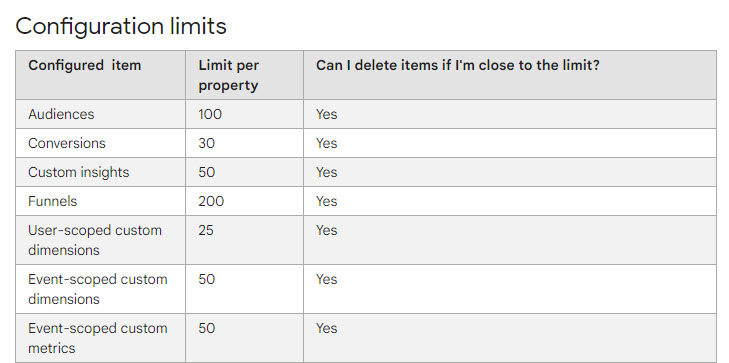
The BigQuery integration will be a great help if you are serious about data analysis. You can run segmented, powerful queries literally in seconds!
Also, it’s very helpful in case you forgot to create custom dimensions or metrics for some of the parameters. They are all waiting for you in BigQuery even if they aren’t registered in GA4.
I recommend setting up the integration as soon as possible even if you haven’t planned to start using it already. You can store your raw data without an expiration date and won’t regret missing historical data!
This is it from my side! I hope you have picked up a few new things about GA4 dimensions and metrics.
What’s your experience with GA4 dimensions and metrics so far?
One last thing... Make sure to get my automated Google Analytics 4 Audit Tool. It contains 30 key health checks on the GA4 Setup.
Leave a Reply